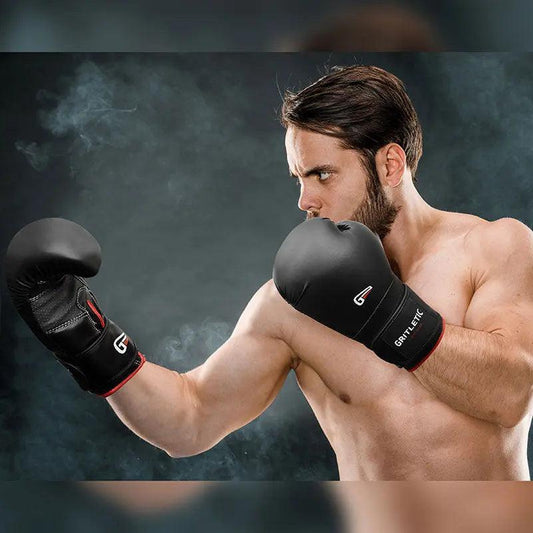| Table of Contents: |
| 1. Introduction 2. History and Origins 3. Rules and Regulations 4. Techniques and Styles 5. Striking Arsenal 6. Clinch and Grappling 7. Defense and Footwork 8. Training Methods 9. Equipment and Attire 10. Strategy and Approach 11. Conclusion: Embracing the Diversity of Combat Sports |
Introduction:
In the dynamic world of mixed martial arts (MMA), combat sports enthusiasts often encounter a variety of disciplines, each with its own unique characteristics and techniques. Two of the most prominent disciplines within MMA are boxing and Muay Thai. While both sports involve striking, they differ significantly in terms of techniques, rules, and strategies. In this article, we will explore the key differences between boxing and Muay Thai in the context of MMA, highlighting the distinct features and contributions of each discipline to the sport.
 History and Origins:
History and Origins:
Boxing, also known as the "sweet science," has ancient roots dating back thousands of years, with evidence of early forms of boxing found in ancient Egypt, Greece, and Rome. Modern boxing as we know it emerged in the late 19th century, with the Marquess of Queensberry rules codifying the sport's regulations and techniques.Muay Thai, on the other hand, originated in Thailand several centuries ago and has deep cultural and religious significance in Thai society. Often referred to as the "art of eight limbs," Muay Thai incorporates punches, kicks, elbows, and knee strikes, making it a comprehensive and versatile striking art.
Rules and Regulations:
In boxing, fighters are limited to using punches above the waist. Strikes below the belt, headbutts, elbows, knees, and kicks are strictly prohibited. The sport is governed by a set of rules that prioritize technique, defense, and sportsmanship.Muay Thai, on the other hand, allows fighters to utilize a wider range of striking techniques, including punches, kicks, elbows, and knees. In addition, Muay Thai permits clinching, where fighters can grapple and control their opponent's movement to set up strikes or takedowns.
Techniques and Styles:
Boxing emphasizes speed, precision, and footwork, with fighters typically relying on a combination of jabs, crosses, hooks, and uppercuts to outmaneuver and outscore their opponents. Defense is a crucial aspect of boxing, with fighters using head movement, blocking, and footwork to avoid incoming strikes.Muay Thai fighters employ a more diverse array of techniques, incorporating punches, kicks, elbows, and knees into their striking arsenal. Muay Thai also emphasizes the clinch, where fighters can control their opponent's posture and leverage to deliver devastating strikes or set up takedowns.
Striking Arsenal:
In boxing, fighters primarily use their fists to deliver strikes, with punches being the primary offensive weapon. Fighters may vary the speed, angle, and power of their punches to create openings and exploit their opponent's defenses.In Muay Thai, fighters have a broader striking arsenal, including punches, kicks, elbows, and knees. Each strike is delivered with maximum power and precision, with fighters often employing combinations to overwhelm their opponents and score points.
Clinch and Grappling:
Boxing does not permit clinching or grappling, as fighters are required to maintain a distance and engage in striking exchanges. Clinching is considered a foul in boxing, and referees will separate fighters if they become entangled or hold onto each other.Muay Thai places a significant emphasis on the clinch, where fighters can grapple, control, and strike from close range. Clinching allows fighters to disrupt their opponent's rhythm, tire them out, and set up devastating strikes or takedowns.
Defence and Footwork:
Defence and footwork are essential components of boxing, with fighters using head movement, blocking, and evasive footwork to avoid incoming strikes and counter effectively. Fighters must maintain a strong guard and stay balanced to defend against their opponent's attacks.In Muay Thai, fighters employ a combination of defensive techniques, including blocking, parrying, and checking kicks. Footwork is also crucial in Muay Thai, with fighters using lateral movement and angles to create openings for their strikes and evade their opponent's attacks.
Training Methods:
Boxers focus on developing speed, power, and endurance through a combination of shadowboxing, bag work, pad work, and sparring. Training emphasises technique, timing, and conditioning, with an emphasis on perfecting fundamental skills and executing combinations effectively.Muay Thai training incorporates a wide range of techniques, including striking, clinching, and grappling. Fighters train with pads, heavy bags, and sparring partners to develop power, precision, and timing in their strikes. Conditioning is also a key aspect of Muay Thai training, with fighters often incorporating strength and endurance exercises into their workouts.
Equipment and Attire:
In boxing, fighters wear padded gloves, hand wraps, mouthguards, and protective headgear during training and competition. Boxing attire typically consists of shorts, a tank top, and boxing shoes, with fighters customizing their gear to suit their preferences and style.Muay Thai fighters use similar equipment, including gloves, hand wraps, mouthguards, and protective gear. However, Muay Thai gloves tend to be more compact and versatile, allowing for a wider range of striking techniques. Muay Thai attire typically includes traditional Muay Thai shorts, a sleeveless shirt, and lightweight footwear.
Strategy and Approach:
Boxers often employ a tactical and strategic approach to their fights, utilising feints, angles, and footwork to outmanoeuvre their opponents and create scoring opportunities. Boxing matches are often characterised by strategic battles of timing, distance, and rhythm, with fighters looking to control the pace and dictate the flow of the fight.Muay Thai fighters adopt a more aggressive and relentless approach, focusing on overwhelming their opponents with a barrage of strikes and clinch work. Muay Thai matches are often fast-paced and action-packed, with fighters trading blows and vying for dominance in the clinch.

















